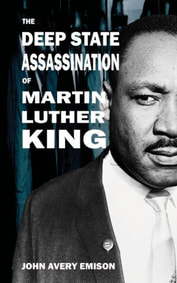 Harry S. Avery of Knoxville was Tennessee’s Commissioner of Correction when Martin Luther King, Jr., was assassinated. Avery was the only official to conduct an independent investigation of the case against accused assassin James Earl Ray, but his findings were officially ignored and unpublished at his death in 1975. Now Avery’s grand-nephew John Avery Emison has published those findings and a good deal more substantive personal testimony about the case that has not yet seen the light of day. His The Deep State Assassination of Martin Luther King (Columbia, South Carolina, 2023) will prove indispensable to anybody wishing to research the assassination of Dr. King — a particularly hot topic in these days of new revelations about the assassination of President John F. Kennedy. Emison, currently mayor of the town of Alamo, Tennessee, himself visited Ray in prison a number of times and spoke with him extensively, and with Ray’s brother Jerry at even greater length, collecting information never before published. Reaching beyond his family and Ray’s, Emison interviewed Ray’s attorney, Judge Arthur Hanes, Jr., and others directly involved in the case: John Jay Hooker, Jr., the Nashville attorney who interrogated Ray, and strenuously, in the prison; Mike Vinson, the journalist who interviewed Ray extensively less than a month before he died. He interviewed others closely involved with Ray after his conviction, among them Harold R. Swenson, Warden of Missouri’s penitentiary at Jefferson City, and Stonney R. Lane, then Warden of Brush Mountain Prison in Petros, Tennessee. Emison’s book, then, is one of those caches of information so rare in the study of history, parallel to William Herndon’s collected interviews of the friends and associates of Abraham Lincoln: a treasury of first-hand testimony gathered from witnesses still living but never before heard. That alone makes the book considerable, indeed indispensable. In addition, Emison supplies original photographs of the site of the assassination and of the armaments alleged to have been used in the murder, with a thorough technical analysis. He also supplies official photos never before seen, or, as from the Library of Congress, too seldom seen. Emison considers all of this and makes sense of it. Additionally, he’s reviewed apparently all of the standing literature on the matter and carefully marshalled instances of its errors, its internal contradictions, its clashes with the indisputable facts, and its plain impossibilities. He presents these anomalies, rectifies them when his evidence permits, and raises sensible questions about them when his evidence does not extend to those matters, thereby mapping the way for further research. Most interesting, too, is Emison’s presentation of surprising facts, indisputable facts as reported in the public record, that we’ve all forgotten about. The fact that Ray never stood trial should pivot our perspective on the whole proceeding of his conviction and incarceration, and in retrospect on his capture — which in turn should bring the evidence for his conviction into review, along with his previous, and anomalous, activities in the months preceding the assassination. Here, Emison lets us see the central void surrounded by all available facts: an emptiness that can be filled only by the hypothesis that James Earl Ray did not act alone, that he was instigated, funded, prepared, and scapegoated by some clandestine agency — by a person or persons as yet unknown. Moreover, the edges of that void fit with disturbing precision to the activities of federal intelligence officers — agents connected by personal acquaintance, employed by a variety of agencies, most of them unauthorized to operate within the United States, and none of them authorized to engineer assassinations of American citizens. The information that Emison tabulates for us supplies ample justification for polemic, and the putative involvement of intelligence agencies and the state of the literature open fertile ground for conspiracy theories that, like serious studies, are proliferating now more than ever before with the revelations about the Kennedy assassination. But Emison is always moderate and measured in his presentation. As a degreed historian he writes accessibly, and, having followed a career in nuclear criticality safety at Oak Ridge, he knows how carefully to handle the potentially explosive material of primary documents. Together, this unique material must stand at the center of the study from now on. Emison’s is the foundation on which to build, or the stone that must be moved, in any future study of Dr. King’s assassination.
1 Comment
Joe Johnson
2/19/2024 05:17:55 am
King may have killled by the Deep State, yet the Deep State used king's odious "Civil Rights Movement" to destroy the last vestiges of jeffersonian democracy. And king was a disgrace who helped to liberate people from work, responsibility, and decency. May he continue to rot in hell.
Reply
Leave a Reply. |
AuthorKevin Orlin Johnson, Ph.D., is author of The Lincolns in the White House (Dallas 2024), available at bookstores everywhere and online at pangaeus.com. Archives |
Proudly powered by Weebly
